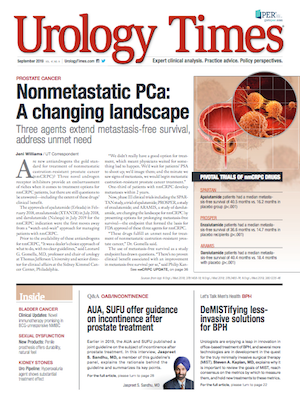Publication
Article
Urology Times Journal
Salvage LND may help delay recurrence
Author(s):
A preliminary study of the use of salvage lymph node dissection in patients with nonmetastatic, castration-resistant prostate cancer indicates the potential to delay disease recurrence as well as the use of systemic therapies through this approach.
A preliminary study of the use of salvage lymph node dissection in patients with nonmetastatic, castration-resistant prostate cancer indicates the potential to delay disease recurrence as well as the use of systemic therapies through this approach.
However, more research is needed to confirm the results-specifically, multicenter studies with a larger cohort, says Luca Boeri, MD, of Mayo Clinic, Rochester, MN, who presented the results at the AUA annual meeting in Chicago.
“For sure, it is like a rock in a lake, but it is worth exploring,” Dr. Boeri told Urology Times.
Nonmetastatic, castration-resistant prostate cancer is a relatively indolent disease, and there is no high-quality evidence to guide clinical decision-making. Currently, the standard of care for patients with this disease is androgen deprivation therapy (ADT). Patients who do not exhibit evidence of bone or visceral metastases are typically managed with observation or ADT.
The AUA study sought to determine whether salvage lymph node dissection could slow disease progression and postpone the use of systemic therapies in men with node-only recurrence.
Dr. Boeri, working with R. Jeffrey Karnes, MD, and colleagues at Mayo Clinic, conducted a retrospective analysis of patients with node-only recurrence who were treated with salvage lymph node dissection or systemic therapies from January 1990 through January 2016. These patients underwent a positron emission tomography/computed tomography scan and conventional imaging to detect possible metastases (detected at 11C-choline PET/CT).
Among the patients in this cohort, 23 (51%) underwent salvage lymph node dissection for lymph node-only recurrence of castration-resistant prostate cancer and 22 (48.9%) received systemic therapies (ADT or chemotherapy) for lymph node-only recurrence of castration-resistant prostate cancer.
ADT patients were treated with a different medication-either alone or in combination with the previous ADT drug used-based on the physician’s discretion. All salvage lymph node dissection procedures were performed by a single surgeon between Nov. 1, 2009 and Dec. 31, 2016.
Biochemical recurrence was defined as a PSA greater than 0.2 ng/mL with an increased trend, while radiologic recurrence was defined as a positive imaging study or biopsy-proven metastasis after salvage lymph node dissection or systemic therapies. The Kaplan-Meier method was used to assess time to biochemical recurrence, radiologic recurrence, and cancer-specific mortality. Predictors of biochemical recurrence and radiologic recurrence were assessed via Cox regression analyses. Median follow-up for the entire cohort was 49.3 months.
Data support role for salvage LND
The results point to the potential for salvage lymph node dissection to be used as a treatment option in men with node-only recurrence of castration-resistant prostate cancer:
• Mean PSA reduction was significantly higher after salvage lymph node dissection than after ADT (62.8% vs. 17.4%).
• Time to PSA nadir was significantly lower in the salvage lymph node dissection group than the ADT group (1.6 months vs. 7.3 months).
• The 5-year cancer-specific mortality rates were 72.7% and 72.3% for salvage lymph node dissection and ADT patients, respectively.
• There was a trend toward longer time to biochemical recurrence (13.3 months vs. 6 months) and radiologic recurrence (21.1 months vs. 14.2 months) in salvage lymph node dissection patients than ADT patients.
• Median time to standard systemic therapy was longer in the salvage lymph node dissection group than that ADT group (66.1 months vs. 43.3 months).
However, one limitation of the study-in addition to the small sample size-is that the results are based on traditional imaging techniques.
“An important dilemma arises if there is room for metastasis-directed therapy for oligorecurrent castrate-resistant prostate cancer detected on advanced imaging,” Dr. Boeri said.





























